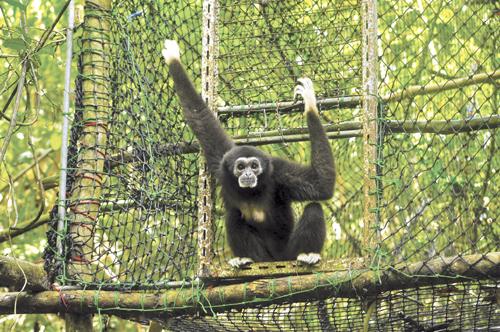Phuket Lifestyle: Call of the wild – a family’s journey out of captivity

for mapHUKET: This past year has been an incredibly busy time at Phuket’s Gibbon Rehabilitation Project (GRP), but fortunately, with the arrival of a new crop of enthusiastic volunteers to help out, the day finally came when the GRP were able to release the 2012 gibbon family (Cop, Jorn and baby Sherpa) into the wild.
On the climb up to the release site to let the new family go, the research team were fortunate enough to come across another reintroduced family whilst passing through their territory.
The family of ‘Kip’ celebrated their 10th anniversary as wild forest gibbons in September of 2012. The adult couple has raised three babies in the wild since their release and the oldest of these wild born offspring has already started her own family.
Those involved in the release said that watching the ‘wild’ family casually foraging in the trees on their way up to release a new and naive gibbon family into the forest, was a good omen.
Since 2002, the GRP has released eight breeding families of gibbons into the local rainforest here on Phuket, and this year it was Cop, Jorn and baby Sherpa’s turn.
The female, Cop, is just ten years old and arrived at GRP in 2004 from Patong Beach, where she had been used as a photo prop for tourists. Her mate, Jorn, had been kept as a pet before his rescue and is eight years old. Sherpa, who turned two in October 2012, is the couple’s firstborn baby.
“This is the youngest family the project has ever released; all three individuals have a wonderful long life ahead of them in the forest and carry a minimal amount of bad experiences from life with humans,” says Petra Osterberg; GRP primatologist and long-term volunteer.
“The process from release to actual independence is lengthy and requires many adaptations and adjustments from the individual animals. We are hopeful that the young ages of this year’s family will make them adapt to the forest easier and more naturally than gibbons who have gathered more traumatic experiences from captivity.”
Since the first day of their release all three gibbons have chosen to stay well off the ground; exploring their new canopy universe with great enthusiasm and ignoring all of the human onlookers below.
Young Sherpa has spent the majority of his waking time learning how to navigate his new forest playground whilst his parents are trying out all of the delicious foliage the surrounding trees have to offer.
Both Sherpa and Jorn have taken a few tumbles to the ground in their first days out, when they misjudged the safety of the branches, but have not let small mistakes hold them back.
“It is to be expected that reintroduced gibbons may have to learn a few lessons the hard way,” says Mr Osterberg.
On day six, Jorn started to sing a tentative solo from one of the high emerging trees next to the release cage and Cop and Sherpa soon rushed to his side to join in the chorus.
It was a great moment for GRP staff and volunteers, listening to the family lay claim to their forest territory and raising their voices for over 20 minutes.
The episode got an abrupt end when Bank, a large adult male from a neighboring group, turned up and started a singing in response from a tree only 150 meters away.
Cop immediately took Sherpa to safety whilst Jorn positioned himself in between his family and the potential intruder. Luckily, on this occasion GRP staff were there to act as protectors of the new family and were able to scare Bank off. In the coming weeks we hope that the family will gain enough confidence in the canopy to ward off any intruders themselves.
Although the gibbons have much to learn, so far they are adjusting extremely well to their new forest home.
However, Mr Osterberg gives a staunch reality check on the program’s often optimistic
outlook:
“Sadly, reintroducing captive- raised primates into the wild is neither a conservation, nor animal welfare, solution to the problem of the illegal wildlife trade in Thailand. The white handed gibbon already became extinct on Phuket in the early 1980s due to the trade.
“Every year new baby gibbons, slow lorises and other wildlife arrive from the mainland to ‘entertain’ the thousands of tourists that travel here each year. Many people are sadly still unaware of the devastating trade that brings exotic wild-born, baby animals into the tourist hotspots for entertainment and as photo-prop animals.
The only way to stop this trade is to stop the demand and to spread the message never to pay for photographs with endangered wild animals.”
All sightings of illegal wildlife used as photo props may be reported to the GRP or directly to the DNP at dnp.go.th/complain/index.asp.
Visitors are always welcome to GRP’s Education center and Rehabilitation site, in order to learn more about GRP’s work and also about the gibbons we have staying with us.
Some of the gibbons that cannot be released can be seen from our viewing platform. We are located at Bang Pae waterfall, 9kms east of the Heroines Monument (click here for map).
Latest Thailand News
Follow The Thaiger on Google News:


























